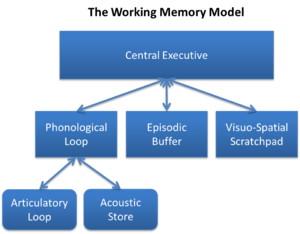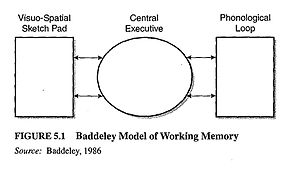Long-term memory (LTM) is the stage of the Atkinson–Shiffrin memory model in which informative knowledge is held indefinitely. It is defined in contrast to sensory memory, the initial stage, and short-term or working memory, the second stage, which persists for about 18 to 30 seconds. LTM is grouped into two categories known as explicit memory and implicit memory. Explicit memory is broken down into episodic and semantic memory, while implicit memory includes procedural memory and emotional conditioning.
A mental event is any event that happens within the mind of a conscious individual. Examples include thoughts, feelings, decisions, dreams, and realizations. These events often make up the conscious life that are associated with cognitive function.
Short-term memory is the capacity for holding a small amount of information in an active, readily available state for a short interval. For example, short-term memory holds a phone number that has just been recited. The duration of short-term memory is estimated to be on the order of seconds. The commonly cited capacity of 7 items, found in Miller's Law, has been superseded by 4±1 items. In contrast, long-term memory holds information indefinitely.
Working memory is a cognitive system with a limited capacity that can hold information temporarily. It is important for reasoning and the guidance of decision-making and behavior. Working memory is often used synonymously with short-term memory, but some theorists consider the two forms of memory distinct, assuming that working memory allows for the manipulation of stored information, whereas short-term memory only refers to the short-term storage of information. Working memory is a theoretical concept central to cognitive psychology, neuropsychology, and neuroscience.
In cognitive psychology, information processing is an approach to the goal of understanding human thinking that treats cognition as essentially computational in nature, with the mind being the software and the brain being the hardware. It arose in the 1940s and 1950s, after World War II. The information processing approach in psychology is closely allied to the computational theory of mind in philosophy; it is also related to cognitivism in psychology and functionalism in philosophy.
The Atkinson–Shiffrin model is a model of memory proposed in 1968 by Richard Atkinson and Richard Shiffrin. The model asserts that human memory has three separate components:
- a sensory register, where sensory information enters memory,
- a short-term store, also called working memory or short-term memory, which receives and holds input from both the sensory register and the long-term store, and
- a long-term store, where information which has been rehearsed in the short-term store is held indefinitely.

In cognitive psychology and neuroscience, spatial memory is a form of memory responsible for the recording and recovery of information needed to plan a course to a location and to recall the location of an object or the occurrence of an event. Spatial memory is necessary for orientation in space. Spatial memory can also be divided into egocentric and allocentric spatial memory. A person's spatial memory is required to navigate around a familiar city. A rat's spatial memory is needed to learn the location of food at the end of a maze. In both humans and animals, spatial memories are summarized as a cognitive map.

Subvocalization, or silent speech, is the internal speech typically made when reading; it provides the sound of the word as it is read. This is a natural process when reading, and it helps the mind to access meanings to comprehend and remember what is read, potentially reducing cognitive load.

Alan David Baddeley CBE FRS is a British psychologist. He is known for his research on memory and for developing the three-component model of working memory. He is a professor of psychology at the University of York.
Information processing theory is the approach to the study of cognitive development evolved out of the American experimental tradition in psychology. Developmental psychologists who adopt the information processing perspective account for mental development in terms of maturational changes in basic components of a child's mind. The theory is based on the idea that humans process the information they receive, rather than merely responding to stimuli. This perspective uses an analogy to consider how the mind works like a computer. In this way, the mind functions like a biological computer responsible for analyzing information from the environment. According to the standard information-processing model for mental development, the mind's machinery includes attention mechanisms for bringing information in, working memory for actively manipulating information, and long-term memory for passively holding information so that it can be used in the future. This theory addresses how as children grow, their brains likewise mature, leading to advances in their ability to process and respond to the information they received through their senses. The theory emphasizes a continuous pattern of development, in contrast with cognitive-developmental theorists such as Jean Piaget's theory of cognitive development that thought development occurs in stages at a time.
Memory has the ability to encode, store and recall information. Memories give an organism the capability to learn and adapt from previous experiences as well as build relationships. Encoding allows a perceived item of use or interest to be converted into a construct that can be stored within the brain and recalled later from long-term memory. Working memory stores information for immediate use or manipulation, which is aided through hooking onto previously archived items already present in the long-term memory of an individual.
In psychology and neuroscience, memory span is the longest list of items that a person can repeat back in correct order immediately after presentation on 50% of all trials. Items may include words, numbers, or letters. The task is known as digit span when numbers are used. Memory span is a common measure of working memory and short-term memory. It is also a component of cognitive ability tests such as the WAIS. Backward memory span is a more challenging variation which involves recalling items in reverse order.
Echoic memory is the sensory memory that registers specific to auditory information (sounds). Once an auditory stimulus is heard, it is stored in memory so that it can be processed and understood. Unlike most visual memory, where a person can choose how long to view the stimulus and can reassess it repeatedly, auditory stimuli are usually transient and cannot be reassessed. Since echoic memories are heard once, they are stored for slightly longer periods of time than iconic memories. Auditory stimuli are received by the ear one at a time before they can be processed and understood.
Memory rehearsal is a term for the role of repetition in the retention of memories. It involves repeating information over and over in order to get the information processed and stored as a memory.
Articulatory suppression is the process of inhibiting memory performance by speaking while being presented with an item to remember. Most research demonstrates articulatory suppression by requiring an individual to repeatedly say an irrelevant speech sound out loud while being presented with a list of words to recall shortly after. The individual experiences four stages when repeating the irrelevant sound: the intention to speak, programming the speech, articulating the sound or word, and receiving auditory feedback.
Musical memory refers to the ability to remember music-related information, such as melodic content and other progressions of tones or pitches. The differences found between linguistic memory and musical memory have led researchers to theorize that musical memory is encoded differently from language and may constitute an independent part of the phonological loop. The use of this term is problematic, however, since it implies input from a verbal system, whereas music is in principle nonverbal.
The development of memory is a lifelong process that continues through adulthood. Development etymologically refers to a progressive unfolding. Memory development tends to focus on periods of infancy, toddlers, children, and adolescents, yet the developmental progression of memory in adults and older adults is also circumscribed under the umbrella of memory development.

Memory is the faculty of the mind by which data or information is encoded, stored, and retrieved when needed. It is the retention of information over time for the purpose of influencing future action. If past events could not be remembered, it would be impossible for language, relationships, or personal identity to develop. Memory loss is usually described as forgetfulness or amnesia.
Unitary theories of memory are hypotheses that attempt to unify mechanisms of short-term and long-term memory. One can find early contributions to unitary memory theories in the works of John McGeoch in the 1930s and Benton Underwood, Geoffrey Keppel, and Arthur Melton in the 1950s and 1960s. Robert Crowder argued against a separate short-term store starting in the late 1980s. James Nairne proposed one of the first unitary theories, which criticized Alan Baddeley's working memory model, which is the dominant theory of the functions of short-term memory. Other theories since Nairne have been proposed; they highlight alternative mechanisms that the working memory model initially overlooked.

Spatial ability or visuo-spatial ability is the capacity to understand, reason, and remember the visual and spatial relations among objects or space.







